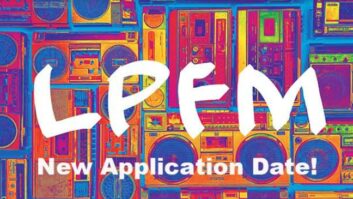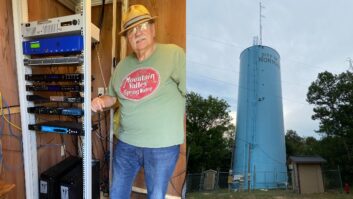Editor’s note: The window for filing applications for new LPFM stations has been pushed back. It will now run from Dec. 6 to Dec. 13. Learn more here.
Radio World has introduced a series of articles titled “Firing Up Frequencies,” intended for readers who may be interested in applying for a low-power FM station license in the FCC’s upcoming window in November 2023. The following story is the second installment in the series.
The author is Sharon Scott, president and co-founder of ART FM, WXOX in Louisville, Ky. Sharon is the author of the new book “Low-Power FM for Dummies.”

For the first time in an entire decade, the FCC has announced a low-power FM filing window for Nov. 1–8, 2023. This is a rare opportunity for nonprofit organizations to get their own spot on the FM dial. This is very exciting but also very intense as there is not much time to get the word out.
My previous article “Get Ready to Fire Up the Frequencies“ gives an overview of what is to be expected of LPFM applicants. In the next few installments, I will break it down step by step. I would like to emphasize that it is easier than you might think to start an LPFM radio station. No experience is required and there is a dedicated community willing to help. The LPFM Resources website provides a list of contacts and other useful information for those looking to get started. Of course there will be expenses; but grants and local support can help make your radio dream a reality. Once your application is granted, you will have three years to get on the FM dial, which is plenty of time to acquire the resources you need.
If you want an LPFM license, the first order of business is determining whether there is availability in your area. To do this, you can use the LPFM Channel Finder on the FCC website or the REC Networks LPFM Wide Area Availability Map.
If there is an available frequency in your area, you will need to get busy finding or founding a nonprofit organization that is willing to apply for the LPFM license. Tribes and government agencies can also apply, but individuals and for-profit businesses cannot. If you are already with a nonprofit, that is fantastic! Below is a checklist you will want to review with your board members to make sure everyone qualifies.
If you are not with a nonprofit, it is easy to get one started, but you will need to do it as quickly as possible. Like, today. To apply for an LPFM license you will need to incorporate as a nonprofit organization with your state. This is an easy process that can be completed in a couple of days. You will NOT need to be a federal tax-exempt 501(c)3 organization. It is advisable to keep the initial Articles of Incorporation as simple as possible to get things started. You will have time to fine-tune your organization later.
Most states require that three individuals serve on the board of directors of a nonprofit organization, but some states only require one. Check the website of your state’s secretary of state for specific details. Some of these sites provide online templates for starting a nonprofit organization that can make the process simple. You may want to hire an attorney to draw up your Articles of Incorporation, or find an advocacy organization that can provide pro bono support. Just make sure to emphasize your need to get this done in a flash!
Localism
The FCC will only award LPFM frequencies to organizations that are local to the community in which they plan to broadcast. They must claim one of the following to qualify:
- Headquarters, branch or campus is located within 10 miles* of the transmitting antenna;
or
- 75 percent of the board members have their primary residence within 10 miles of the transmitting antenna.
*This distance is extended from 10 to 20 miles for organizations outside of the Top 50 radio markets. A list of counties within the Nielsen Top 50 markets can be found on the REC Networks website.
LPFM Board Expectations
The FCC holds nonprofit LPFM board members to the following expectations. It is important to review the following information with your board prior to submitting the LPFM application:
- 80 percent or more of the board of directors must be U.S. citizens.
- Board members and their families may not have ownership interest in any other broadcast licenses, daily newspapers or cable TV systems.
- Anyone that has been dishonest with the FCC in previous proceedings may not serve on the board of an LPFM.
- Directors may not have been convicted of felonies for crimes involving discrimination or providing fraudulent statements to the U.S. government.
- Directors may not have a conviction that has resulted in the loss of federal benefits under the U.S. Anti-Drug Act.
- Directors cannot have engaged in the operation of an unlicensed broadcast station.
- Applications can be dismissed for infractions of these guidelines. Directors who jeopardize the license in regards to any of the above regulations should resign from the board and look for other ways they can serve the organization.
[Sign Up for Radio World’s SmartBrief Newsletter]
LPFM Priority Points
In rural areas where there is ample airspace, most organizations should be able to find their own spot on the dial. In urban areas where there is only one or two available frequencies, the competition will be much more intense.
If multiple organizations apply for the same frequency within the same area, the FCC will place them in a MX group. MX is short for Mutually eXclusive, meaning that if one of these applicants is granted, the others would have to be excluded. If the applicants cannot work out an agreement (such as sharing the frequency), the FCC will use a point system to determine which applicants have priority. These “Priority Points” are something to keep in mind when finding or founding your nonprofit.
One point will be awarded for each of the following:
- An established community presence of two years or more
- Local program origination — A pledge to create local programming at least eight hours a day
- Main Studio — A pledge to have main studio within 10 miles of transmitter that is staffed and publicly accessible at least 20 hours a week between 7 a.m. and 10 p.m. To get this point, applicants must provide a phone number and address for the proposed main studio when filing their application.
- Local program origination and main studio — bonus point for both items two and three above
- Diversity of ownership — Applicants host no attributable interested in another broadcast station
- Tribal Applicants serving Tribal Lands — to qualify, 51 percent or more of the organization is controlled by tribe or tribes as set forth in §73.7000
Note: If the point system is not employed to win the frequency, the LPFM licensee does not have to uphold the local programming and main studio pledges. LPFM licensees must continue to meet the localism requirements, regardless of the MX status of the application.
Diversity of Ownership — Exceptions to the rule
For the most part, organizations can only apply for one LPFM frequency (though with the possibility of up to two future FM translators, separate licenses that rebroadcast the LPFM signal to extend the coverage area). There are a few exceptions.
Tribal Applicants
Tribal organizations on tribal land may hold two LFPM stations and up to four translators.
Public Safety Organizations
In instances where there is no other competition, public safety organizations run by government agencies may apply for additional LPFM frequencies within their jurisdiction.
Accredited Educational Institutions
Accredited Educational Institutions with an attributable interest in a non-student run broadcast station can apply for an LPFM license that will be operated and managed by the students of the institution.
Established Community Presence
If you do not have the two years of community presence described earlier and believe there will be competition for your frequency, you should consider partnering with an older organization. They can apply for the license on your behalf. Eighteen months after their construction permit is granted and they will be able to turn it over to another organization that qualifies for the same amount of Priority Points.
Since you will have three years to build your station, your organization will have time to acquire the two-year priority point before the original permit expires. Just be very careful with these type of partnership situations. Make sure your values align and all the organizational responsibilities are clear. Know that the organization that holds the license can decide to transfer it or turn it back into the FCC at any point.
The FCC will allow organizations within a MX group with the highest number of priority points to create partnerships and aggregate their score in order to win the frequency. These arrangements are limited to three proponents. Like-minded organizations in competitive areas may consider applying for the same channel with this in mind if they can think of creative ways to share the frequency.
Connect the Advocates
Once you have built or identified a nonprofit organization to submit an LPFM application, you should contact an engineer or advocacy group right away. Nonprofit organizations Common Frequency and International Media Action are ready with engineering and application assistance. Brown Broadcast Services and REC Networks are among the LPFM-friendly engineering firms that can also provide full LPFM support.
Don’t worry if you aren’t sure how to run an LPFM station or what to do after you apply. The Grassroots Radio Conference, hosted by WTSQ in Charleston this Oct. 19–22, will provide a LPFM track with advice for winning your frequency and building your community station. Watch this column for future installments on building a new LPFM station, including locating a tower site, collecting the necessary materials and winning your FM frequency!
[Read more about the promise and challenges of low-power broadcasting in “An LPFM Window This Fall Presents Opportunities”]











